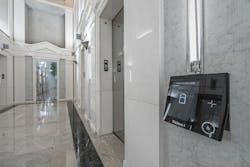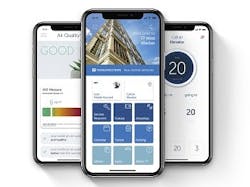Editor’s note: This is part 2 of a two-part series on destination dispatch elevators. Read Part 1 first.
Before an owner meets with an elevator manufacturer and their salesperson, you want to meet face-to-face with an elevator consultant and a security or technology consultant. The consultants should interview you and identify what elevator features you are looking for. A short list of elevator features includes.
- Call services
- Very Important Person (VIP) segregation, Handicapped/dedicated access, restricting floor or limiting the number of people per floor based on time/day schedule that is driven by the access control system and floor recall for fire and non-fire emergencies.
- Reporting
- Bi-directional integration between security system and destination dispatch system to support floor tracking, access usage, and visitor usage that integrates into access control system reporting. Reporting can also include heartbeat monitoring of systems and when lost network connections. How is the communication facilitated? For instance, is it an alarm, is it an email? How will you be notified? Select systems can also monitor occupants to minimize the potential for floor surfing and service key issuance.
- In some instances, third-party integrations or middle ware may be required.
- Integrated access control readers. Can the DD Reader support/read and pass card holder information for all of your tenants and base building? Will you need a separate card. Does it support all frequencies such as 125 KHz, 13.56 MHz, nearfield communication (NFC), bluetooth (BLE) Note: 125 KHz, also known as “prox” readers, use an extremely old technology called the Wiegand effect. They represent the overwhelming percentage of installed and currently being sold card readers. They are also inherently insecure and should be replaced in sensitive, high risk areas. The preference is to ensure these systems support 13.56 MHz and more importantly mobile, BLE and NFC communication.
Some features will need additional validation and discussion. DD kiosks can include access control readers, and regrettably, not all access control cards and readers are the same and certainly we need to prepare for the possibility of autonomous robots augmenting security patrols.
After becoming familiar with the features of the system, documentation of the integration approach needs to occur. Understanding how we want these systems to integrate helps define what information to put in the elevator system and what information to put in the access control system. Ultimately, the access control system sets all aspects of access to the DD system – including, but not limited to – days, time zones, accessible floors, and a home floor.
Floors are assignable by the access control system, typically via fields, allowing for multiple floor groupings or individual floors. The DD system should synchronize all data that is access control related to the security system database, to include: access control credentials for all building management staff, presentation, valid/invalid response, floor selection, floor access/tracking, system status, and alarm activations (such as intercom, use of key switch, door hold alarm and similar). The access control systems should be the single source of truth, and the DD systems should not be able to override or supersede that access.
The integration requires leveraging an application programming interface (API) from the access control system to the DD system. The access control–elevator service (custom) integration, if unwritten, takes time to design, code, test, debug, and refine, and it will be expensive. The API must do a myriad of things, but one critical item is to synchronize the systems, otherwise corruption can ensue between databases.
Keys to Getting What You Want
Consider white boarding and visualizing your intent with pictograms and finite operational sequences for system operation under varying conditions. Leveraging consultants to support you in this process will help you understand how visitors, turnstiles, and other integrations operate and interface with the DD system. Consultants should:
- Ask informative questions on features and operations (i.e. Consider how security will bypass turnstiles if an occupant goes to a floor other than their home floor.)
- Involve those knowledgeable about networking, computer systems, and data interface functions.
- Support the continual progression and documentation of the integration desired.
- Develop specifications/drawings, which communicate the features desired and their operations in a narrative.
Partners?
Integration means that both manufacturing parties need to be locked developmentally at the hip. Without a present, attentive partner and communication, things can fall apart quickly.
A cautionary tale is that integrations may be discontinued, changed, or lock you into a system that cannot be upgraded, and thus, should be certified by respective manufacturers that seek to cooperate technologically. To avoid challenges in the future, ensure that the API is well documented and is backward/forward compatible with security system versions. It is undesirable for a software upgrade to invalidate your API on either the DD system or the security system.
The other crucial element in this process is to collect samples of base building access control cards, tenant cards, and any other access control credential – such as credentials specific to DD elevators systems specifically. Ensure that the elevator contractor has fully tested and confirmed that cards and phones will work and can process authentication data before signing on the dotted line. It is possible for a system to read a card but not be able to process the card's bit length, which could mean two/three cards to a access the building.
The security or technology consultant should work hand-in-hand with the elevator consultant. Together, they will define and document the integration so when the DD system is completed after 1-2 years, you will have something that can be audited. Their documentation forms the contract that will minimize the wiggle room for a salesperson, manufacturer, and, ideally, will tie the elevator manufacture to that integration and the promises made.
Case Studies in Chicago, Illinois
An example of the complexity and competing challenges with a DD system is best articulated by the Salesforce Tower Chicago project. Affiliated Engineers, Inc. partnered with Hines Interests Limited Partnership to deliver an integrated access control system that would use a DD platform to control elevators.
Prior to COVID-19, the owner desired a biometric/Bluetooth reader that would limit the need for tenants to have identification cards on their person. In this unique scenario, the access control specification happened before the selection of the DD elevator system. The challenge was to define a specification that holistically would address the integration of biometric readers into potential DD providers.
We specified the functionality of these systems and integrated access control readers within turnstiles that would call up DD LCD panels, which communicated home floor information to tenants accessing the lobby. We additionally designed multiple connections from the security system through multiple network interface cards to support polling/heartbeat monitoring and a backup cable in the event a connection was severed by a future wayward contractor within a ceiling space.
The biometric reader will probably not be used, but card credentials were coordinated between elevator specification and the security systems specifications. Many of the features that were discussed in the integration approach and identified in the image are present. At the time of this writing, the owner is investigating another integration through the use of a building app that will support access control natively and outside the dedication dispatch and security system. While separate, similar integrations that were discussed above would still be required.
On a recent call, Salvatore DAgostino, a professional colleague with Security Industry Association (SIA), vocalized the work he’s doing around DD systems. His story begins with an extensive system upgrade: including a DD system, access control, video surveillance system, mobile credentialling, visitor management, and tenant experience app. The goal of the project to create a touchless/frictionless environment for 77 West Wacker in Chicago, Illinois, a Class A commercial office building of nearly one million square feet with 50 stories and 24 elevators.
For an enhanced tenant experience, the system integrates access, destination dispatch and an innovative intelligent building mobile app by Cohesion. Leveraging single sign on, tenants can access their mobile access credential, remotely call elevators, register visitors, access indoor air quality, live chat with building management, generate service requests, and reserve building amenities in real-time.
This tool shows that smart building technology can be leveraged to enhance building systems while addressing demand for touchless amenities and greater transparency during the height of the novel coronavirus. The DD system also hosts Bluetooth readers which allow for a VIP touchless experience and segregating/dedicated elevating experience. The certified API integration for the security system, elevator system, and building management applications were a critical step in the DD completion, which began with defining the systems and the functionality desired.
Final Considerations
Consultants must consider cyber security, edge devices, and DD elevator systems themselves, which are basically proprietary/closed-network systems. If we connect a cloud-based visitor management system to a security system, which then connects to an elevator system, there is the possibility of a breach and hacking of the elevator system.
Good cyber hygiene practices need to be in place throughout the system. Beyond cyber, privacy and biometric regulations govern the use of personal/private information. This will become more important in the future. This is noteworthy, because many of these APIs are passing identifying information in clear text, which in non-technical terms is unsecure (exposed) person and machine-readable sensitive data.
Thus, when considering a DD system, evaluation of regulatory concerns is also important. What private information is being supplied and transmitted? The registration process needs to consider the handling and use of personally identifiable information—in particular, the storage of this data for reuse and the data controller for this information.
As these systems continue to proliferate, a DD to security communication should use secure inter-communications Transport Layer Security (TLS) or Secure Socket Layer (SSL). Ideally, a standard protocol and the database fields would replace the custom protocols. To get to interoperability, elevator manufacturers will move away from their proprietary models. This will better ensure that the integration can be maintained over the life of the systems, which is clearly not the case now.
The keys to success of these projects are rooted in planning, team members asking the right questions, and documentation. Many people are purchasing systems without documentation, only to find out that the verbal promises are unfounded, and the term integration is not what was described in any dictionary. Outside of this, some may find it difficult to capture the functionality and leave the owner with an unpleasant taste in their mouth. Their only recourse will be for the owner to swallow their aspirations and live with the sales person's perception of the word' integration.
About the Author:
Sean A. Ahrens ([email protected]), CPP, FSyl, CSC, is a premises liability expert and a board of directors’ member with the International Association of Professional Security Consultants (IAPSC). Ahrens provides security consulting, assessment and security design solutions to its projects that reduce security exposures within domestic and international markets for Affiliated Engineers, Inc. Special thanks to Salvatore DAgostino for his contributions and peer review. Salvatore can be reached at [email protected].
Read next: 3 Ways to Know It's Time for Elevator Maintenance
About the Author

Contributed Author
BUILDINGS partners with industry experts to bring you contributed content covering the hot topics for building owners and facility professionals.


